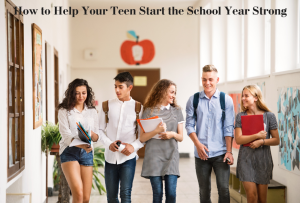Summer break can feel like a bit of a relief — no more packing lunches, rushing out the door, or squeezing family time into busy school nights. But if you’re parenting a tween or young teen, summer can also bring questions. How much freedom is too much? Should she be doing more… or doing less? What’s actually good for her right now?
Girls in the 12–14 range are in that in-between space: they are not little kids anymore, but they’re not fully independent either. They want more freedom, but still need support; they crave downtime, but get bored easily. And while they might act like they don’t need you as much, this is still a stage where your involvement makes a difference.
Here’s what the research says about summer activities for tween girls, and how you can support your daughter with a balance of freedom, structure, rest, and connection.
Why Tween Girls Still Need Structure During Summer
While summer offers a break from the daily school routine, some structure is still helpful, especially for younger teens. A complete lack of routine can lead to irregular sleep, significantly decreased physical activity, and increased screen time and mood disruption. Research confirms that more structured days are associated with healthier behaviours and more positive emotional outcomes compared to fully unstructured ones (Brazendale et al., 2017).

What works best is a bit of both: a mix of planned activities (like camps, classes, or family outings) and wide-open days helps keep them engaged without feeling boxed in. You might anchor each day with a few consistent elements: a set wake-up time, family dinner, an hour of reading or outside time — enough to give the day shape without micromanaging every moment.
Tip: Involve her in creating a simple summer schedule. Giving her a say builds buy-in and supports the growing need for independence.
The Benefits of Unstructured Summer Time for Tween Girls
It’s tempting to fill up their time with enrichment activities, especially when we’re trying to make the most of summer. But research shows that unstructured time and mild boredom can spark creativity and self-directed learning. In fact, time away from external goals can foster internal motivation and originality (Anderson & Jiang, 2018).
Letting her get bored (within reason!) can lead to problem-solving, imagination, and even confidence. When she figures out what to do with her time, whether it’s baking, drawing, making a playlist, or organizing her closet, she’s learning to direct her own energy as well as manage her free time.
Tip: Support her in starting a small project of her own choosing. No outcome pressure. Just something that feels hers — from idea to execution.

How to Support Your Daughter’s Social Life Over Summer

Around this age, friendships become everything. And while school provides built-in daily contact, summer can be more isolating if there’s no plan. On the other hand, too much unstructured or unsupervised time with peers can lead to more risk-taking and externalizing behaviours.
Peer relationships are central to emotional development — and how parents show up matters. Even outside the school year, emotionally supportive parenting fosters resilience and protects against mental health risks (National Academies of Sciences, Engineering, and Medicine, 2019).
Tip: Help her make a few solid plans each week: a low-key hangout, a group movie night, a shared class or camp. Also, encourage offline connection when you can. Even casual family outings with a friend in tow count.
Encouraging Independence in Tween Girls (Without Letting Go Completely)
This is a great age to experiment with independence in manageable ways. Trying out new activities — or taking more ownership of familiar ones — helps build both autonomy and confidence.

The most effective kind of parenting at this stage is what psychologists call autonomy-supportive parenting — and what I call the Supportive Mentor in my parenting style quiz. It’s about offering warmth and guidance while giving teens room to choose and act.
A 2022 study with over 14,000 daily reports found that on days when parents showed more warmth and supported autonomy, teens reported higher well-being in over 90% of families (Bülow et al., 2022).
Tip: If she’s interested in a new activity — like playing a sport, volunteering, or learning a skill — let her take the lead in exploring it. Offer to help if needed, but try not to take over.
Mental Health Matters: Creating Space for Emotions
Summer can bring joy and relief — but also transitions, social stress, or anxiety about the upcoming school year. Girls this age may not always have the language to name what they’re feeling, and emotions can sometimes show up sideways (irritability, withdrawal, overexcitement).
Supportive adult presence and emotionally safe summer environments can buffer youth from stress and promote resilience (National Academies of Sciences, Engineering, and Medicine, 2019). And that support matters more than ever:
- In Canada, about 1 in 4 youth aged 12–17 report experiencing a mental health condition such as anxiety or depression. Hospitalizations for mental health concerns among girls in this age group have increased by more than 60% over the past decade (CIHI, 2022).
- In the United States, recent surveys show similar trends. According to the CDC, nearly 1 in 3 teen girls report persistent feelings of sadness or hopelessness — a number that has more than doubled over the past decade (CDC, 2023). The APA also reports rising levels of anxiety and distress among adolescents, with social isolation and academic pressure among key contributing factors (APA, 2023).
But this is not about creating alarm: it’s about reminding ourselves how much emotional steadiness and connection still matter.
Tip: Check in without prying. A simple, “How’s your summer feeling so far?” can open the door. And if she doesn’t want to talk? Just be nearby. Presence often says more than words.

Staying Connected When She Says She’s Fine
At this stage, it’s easy to assume that more independence means less need for connection — but the opposite is often true. Girls in early adolescence still want closeness with parents (even if they roll their eyes). It just looks different than it did a few years ago.
Even small, everyday moments of connection — a quick chat in the car, making a snack together, walking the dog — are meaningful. Studies continue to show that parent-child warmth remains a protective factor against mood challenges, even as independence grows.
Tip: Focus less on deep talks and more on shared time. Emotional closeness often happens in the in-between moments, not when we push for it.
Final Thoughts: A Summer That Supports Growth
You don’t need to engineer a perfect summer. You just need to create the kind of environment where she can rest, explore, and try things out — knowing you’re there when she needs you.
The right mix of:
- Structure and freedom
- Social time and family time
- Play and growth
…is what helps younger teen girls come out of summer feeling more confident, more connected, and more themselves.
And if that means the occasional late night, unfinished project, or change of plans? That’s okay too.
Real growth isn’t always neat. But it’s happening — right under your roof.
Curious how your parenting style supports your daughter’s independence?
In my parenting style quiz, the Supportive Mentor style reflects many of the qualities linked to stronger teen well-being — things like emotional availability, trust, and just the right amount of guidance.
Wondering which style you lead with — and how to make the most of it this summer?
Parenting an older teen?
My next post focusses on supporting girls aged 15–17 through a summer of real-world growth, emotional well-being, and readiness for what comes next.
References
- Anderson, M., & Jiang, J. (2018). Teens, Social Media & Technology 2018. Pew Research Center. https://www.pewresearch.org/internet/2018/05/31/teens-social-media-technology-2018
- Brazendale, K., et al. (2017). Understanding differences between summer vs. school obesogenic behaviors of children: The Structured Days Hypothesis. International Journal of Behavioral Nutrition and Physical Activity, 14(1), 1–11. https://doi.org/10.1186/s12966-017-0555-2
- Bülow, A., Neubauer, A. B., Soenens, B., Boele, S., Denissen, J. J. A., & Keijsers, L. (2022). Universal ingredients to parenting teens: Parental warmth and autonomy support promote adolescent well-being in most families. Scientific Reports, 12, 16836. https://doi.org/10.1038/s41598-022-21071-0
- CIHI (2022). Mental Health of Children and Youth in Canada. Canadian Institute for Health Information. https://www.cihi.ca/en/mental-health-of-children-and-youth-in-canada
- National Academies of Sciences, Engineering, and Medicine. (2019). Shaping Summertime Experiences: Opportunities to Promote Healthy Development and Well-Being. https://doi.org/10.17226/25546
- Centers for Disease Control and Prevention (CDC). (2023). Youth Risk Behavior Survey. https://www.cdc.gov/healthyyouth/data/yrbs/index.htm
- American Psychological Association (APA). (2023). Adolescent mental health. https://www.apa.org/news/press/releases/stress/2023










